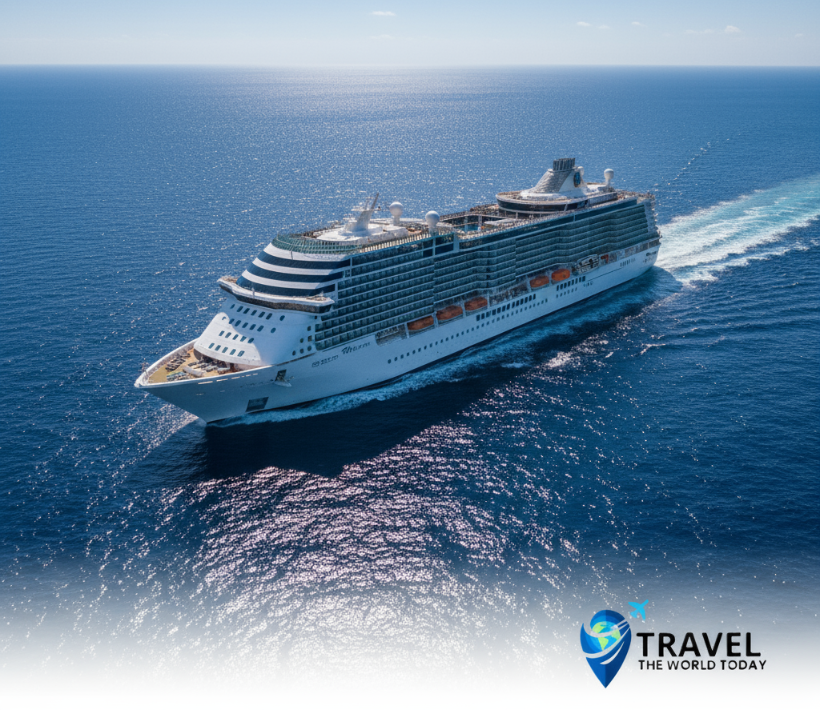How Fast Do Cruise Ships Travel Across the Ocean?
Did you know that modern cruise ships travel at speeds slower than cars on highways, yet they can cross entire oceans carrying over 6,000 passengers? If you’re wondering how fast do cruise ships travel, the answer might surprise you. The average cruise ship maintains a cruising speed of just 20-24 knots (23-28 mph), which seems modest considering these floating cities weigh over 100,000 tons. Understanding how fast do cruise ships travel helps you plan your voyage, set realistic expectations, and appreciate the engineering marvel behind your ocean adventure.
Whether you’re booking your first Caribbean getaway or planning a transatlantic crossing, knowing how fast do cruise ships travel impacts everything from itinerary selection to shore excursion timing. This comprehensive guide reveals the speeds of different cruise vessels, what affects their velocity, and why these massive ships don’t travel at top speed across the waves.
Travel The World Today guides you through every stage of your journey planning, from understanding vessel capabilities to finding the best resources, such as travel maps, that help you visualize your route across the ocean.
Understanding Cruise Ship Speed Basics
What Is the Average Speed of a Cruise Ship?
When people ask how fast do cruise ships travel, most modern cruise ships maintain an average speed of 20 to 24 knots during regular cruising conditions. This translates to approximately 23 to 28 miles per hour (37 to 44 kilometers per hour). While this might seem slow compared to land-based travel, it’s the optimal speed for these massive vessels.
Maximum speeds for cruise ships typically range from 22 to 30 knots, depending on the vessel’s design and engine capacity. However, ships rarely operate at maximum speed except in emergencies or when making up time due to weather delays. The question of how fast do cruise ships travel depends heavily on the cruise industry’s priorities: fuel efficiency, passenger comfort, and safety over raw speed.
Different ship classes maintain different cruising speeds. Mega-ships carrying 5,000+ passengers typically cruise at the lower end of the speed range, while smaller luxury vessels might maintain slightly higher speeds when you consider how fast do cruise ships travel in various categories.
How Cruise Ship Speed Is Measured (Knots vs. MPH)
Maritime travel uses knots as the standard speed measurement rather than miles per hour. One knot equals one nautical mile per hour, which is approximately 1.15 standard miles per hour. This measurement system dates back centuries and remains the international standard when measuring how fast do cruise ships travel.
Why knots instead of mph? Nautical miles are based on the Earth’s coordinates, making them more practical for ocean navigation. One nautical mile equals one minute of latitude, which simplifies chart reading and position plotting for ship navigation systems.
When you see a cruise ship’s speed listed as “22 knots,” you can quickly convert it by multiplying by 1.15 to get approximately 25.3 mph. Understanding this conversion helps answer how fast do cruise ships travel in terms you can relate to everyday driving speeds.
How Fast Do Different Types of Cruise Ships Travel?
Modern Large Cruise Ships
Contemporary mega-ships from lines like Royal Caribbean, Carnival, and Norwegian typically cruise at 21-24 knots (24-28 mph). When examining how fast do cruise ships travel in the mega-ship category, these vessels prioritize stability and comfort over speed. Ships like Symphony of the Seas or Wonder of the Seas maintain consistent speeds that minimize motion and maximize fuel efficiency.
The largest cruise ships, weighing over 225,000 gross tons, have maximum speeds of 22-23 knots but rarely exceed cruising speed. Their massive size creates significant water resistance, and understanding how fast do cruise ships travel at this scale reveals why pushing these ships faster would dramatically increase fuel consumption without substantial time savings.
Mid-sized ships in the 50,000-90,000 ton range often achieve slightly higher speeds of 23-25 knots. These vessels balance passenger capacity with performance, affecting how fast do cruise ships travel across various itineraries.
Expedition and Small Luxury Ships
Expedition cruise ships designed for polar regions and remote destinations typically travel at 14-18 knots (16-21 mph). When considering how fast do cruise ships travel in expedition categories, these smaller vessels prioritize maneuverability and ice-breaking capabilities over speed. Ships like those operated by Lindblad Expeditions or Hurtigruten focus on getting to difficult-access locations.
Luxury small-ship cruises often maintain speeds of 18-22 knots. Vessels from lines like Seabourn, Silversea, and Regent Seven Seas demonstrate how fast do cruise ships travel when passenger comfort meets efficient design. These ships can sometimes achieve higher speeds due to their smaller size and powerful engines.
Yacht-style cruise ships carrying fewer than 500 passengers may reach 25-28 knots at maximum capacity. Their streamlined designs show how fast do cruise ships travel when favorable power-to-weight ratios allow for faster transit.
River Cruise Ships
River cruise vessels operate at much slower speeds than ocean-going ships, typically traveling at 12-15 knots (14-17 mph) maximum. Understanding how fast do cruise ships travel on rivers requires recognizing that actual cruising speeds are often just 8-12 knots due to river currents, narrow waterways, and lock systems.
European river cruises on the Rhine, Danube, or Seine maintain speeds that allow passengers to enjoy scenic views while navigating safely. When examining how fast do cruise ships travel in riverine environments, these ships must account for other river traffic, bridges with limited clearance, and strict speed regulations.
River currents significantly impact actual travel speed when determining how fast do cruise ships travel upstream versus downstream. Ships traveling downstream make faster progress, while upstream travel requires more power and time.
Factors That Affect How Fast Do Cruise Ships Travel
Weather Conditions and Ocean Currents
Ocean currents can add or subtract several knots from a cruise ship’s effective speed. The Gulf Stream, for example, flows at 2-5 knots and significantly impacts how fast do cruise ships travel on transatlantic crossings. Ships traveling with the current make faster progress, while those traveling against it must increase engine power to maintain schedule.
Wind resistance becomes a major factor for large cruise ships with massive superstructures that act like sails. Headwinds can reduce effective speed by 2-4 knots, while tailwinds provide a modest boost. Understanding how fast do cruise ships travel requires accounting for how captains adjust speed and course to optimize fuel consumption in varying wind conditions.
Wave conditions force speed reductions for passenger safety and comfort. In rough seas with waves exceeding 15 feet, the question of how fast do cruise ships travel changes dramatically as captains typically reduce speed to 15-18 knots to minimize ship motion and prevent damage.
Fuel Efficiency and Environmental Regulations
Fuel costs represent one of the largest operational expenses for cruise lines, accounting for 8-12% of total operating costs. Ships consume 30-50 tons of fuel per day at cruising speed, but consumption increases exponentially at higher speeds. When evaluating how fast do cruise ships travel, consider that traveling at 24 knots versus 22 knots can increase fuel consumption by 20-30%.
Environmental regulations now require cruise ships to operate more efficiently. Emission Control Areas (ECAs) in places like the Caribbean, North Sea, and along North American coasts mandate cleaner-burning fuels and limit sulfur emissions, which directly impacts how fast do cruise ships travel in these zones.
Modern ships use slow steaming strategies to reduce emissions and fuel costs. By maintaining speeds at the lower end of their range (20-22 knots), cruise lines demonstrate how fast do cruise ships travel when achieving optimal fuel efficiency while still meeting itinerary requirements.
Port Schedules and Itinerary Planning
Fixed arrival times at ports determine exactly how fast do cruise ships travel between destinations. If a ship has 300 nautical miles to cover in 15 hours, it needs to maintain an average speed of 20 knots. Shore excursions, pilot boarding times, and port authority requirements create inflexible schedules.
Buffer time is built into cruise itineraries to account for delays. Ships rarely operate at maximum speed because captains maintain a buffer that allows them to make up time if weather or other factors cause delays, affecting how fast do cruise ships travel throughout the journey.
Fuel optimization software now helps cruise lines plan speeds for entire itineraries. These systems calculate how fast do cruise ships travel most efficiently for each leg of the journey, sometimes varying speed throughout the day to arrive at ports at optimal times.
The Fastest Cruise Ships in Operation Today
| Ship Name | Cruise Line | Maximum Speed | Cruising Speed | Notable Features |
|---|---|---|---|---|
| Queen Mary 2 | Cunard | 30 knots | 26 knots | Built for transatlantic speed |
| SS United States (historical) | United States Lines | 38+ knots | 35 knots | Fastest passenger ship ever (now retired) |
| Oasis Class Ships | Royal Caribbean | 22.6 knots | 22 knots | World’s largest ships |
| Celebrity Edge | Celebrity Cruises | 24 knots | 22 knots | Modern outward-facing design |
| MSC World Europa | MSC Cruises | 23 knots | 20-22 knots | LNG-powered efficiency |
| Norwegian Joy | Norwegian Cruise Line | 25 knots | 23 knots | Purpose-built for Asia routes |
| Carnival Jubilee | Carnival | 23.7 knots | 21-22 knots | Excel-class efficiency |
| Disney Wish | Disney Cruise Line | 23.6 knots | 22 knots | Family-focused amenities |
Cunard’s Queen Mary 2 remains the fastest passenger ship in regular service, specifically designed for rapid transatlantic crossings. When comparing how fast do cruise ships travel, her powerful engines and streamlined hull allow sustained speeds of 26-28 knots, cutting traditional crossing times by a full day.
The legendary SS United States holds the transatlantic speed record at over 38 knots, but this historic vessel hasn’t sailed since 1969. When examining how fast do cruise ships travel historically, no modern cruise ship comes close to this speed, as contemporary designs prioritize capacity, comfort, and efficiency over raw velocity.
Most new cruise ships launched after 2020 focus on environmental performance rather than speed. LNG-powered vessels and those with advanced hull designs demonstrate how fast do cruise ships travel while achieving better fuel efficiency at moderate speeds, making 22-23 knots the new industry standard.
Why Don’t Cruise Ships Travel Faster?
Safety Considerations
Passenger safety requires moderate speeds that allow sufficient reaction time for collision avoidance. At 20-22 knots, captains have adequate time to detect and avoid hazards. Understanding how fast do cruise ships travel from a safety perspective reveals why higher speeds would reduce this critical safety margin.
Stopping distances for cruise ships are measured in miles, not feet. A large cruise ship traveling at 22 knots requires 1.5 to 2 miles and 10-15 minutes to come to a complete stop. The question of how fast do cruise ships travel safely must account for these extended stopping distances.
Navigation regulations limit speeds in certain areas. Ports, harbors, and coastal zones often have mandatory speed limits of 10-15 knots to protect swimmers, small boats, and marine mammals, directly affecting how fast do cruise ships travel in these zones.
Passenger Comfort and Stability
Motion sickness becomes more prevalent at higher speeds when ships encounter waves. The up-and-down pitching motion intensifies as speed increases. When cruise lines consider how fast do cruise ships travel, they prioritize smooth sailing over rapid transit to minimize passenger discomfort.
Stabilizer systems work best at moderate speeds. Modern cruise ships use active fin stabilizers to reduce rolling motion, but these systems become less effective at speeds above 24 knots. Maintaining optimal stabilizer performance directly influences how fast do cruise ships travel.
Vibration and noise increase exponentially with speed. Engines running at maximum capacity create vibrations that passengers can feel throughout the ship. The decision about how fast do cruise ships travel balances speed with ensuring a peaceful onboard experience.
Economic Factors
Fuel costs rise dramatically with speed increases. The relationship between speed and fuel consumption follows a cubic curve, meaning a 10% speed increase can result in a 30% increase in fuel consumption. This economic reality defines how fast do cruise ships travel in practical operations.
Engine maintenance costs increase with higher speeds. Operating engines at maximum capacity accelerates wear and tear, reducing time between maintenance cycles. The determination of how fast do cruise ships travel must consider long-term operational costs beyond immediate fuel expenses.
Itinerary flexibility suffers when ships operate at maximum speed. Without speed reserves, cruise lines cannot make up time lost to weather delays. Understanding how fast do cruise ships travel reveals that operating at moderate speeds provides operational flexibility worth more than slightly faster travel times.
How Long Do Ocean Crossings Take at Cruise Ship Speed?
Understanding how fast do cruise ships travel helps you estimate journey times for popular routes. Here are realistic travel times:
Transatlantic Crossing (New York to Southampton):
- Distance: Approximately 3,150 nautical miles
- Average cruise ship speed: 22 knots
- Travel time: 6-7 days
- Queen Mary 2 (at 26 knots): 5-6 days
- This demonstrates how fast do cruise ships travel on history’s most famous ocean route
Miami to Caribbean (Eastern Caribbean Loop):
- Distance: Approximately 1,200-1,500 nautical miles
- Average speed: 20-22 knots
- Travel time: 7 days with port stops
- Pure sailing time: 2.5-3 days
- Understanding how fast do cruise ships travel on short routes shows efficiency
Los Angeles to Hawaii:
- Distance: Approximately 2,500 nautical miles
- Average speed: 21 knots
- Travel time: 5 days one-way
- Typical cruises: 15 days round-trip
- How fast do cruise ships travel to Hawaii affects vacation length planning
Panama Canal Transit (Caribbean to Pacific):
- Distance: Approximately 50 nautical miles through canal
- Canal transit time: 8-10 hours (slow speed required)
- Full voyage (Florida to California): 14-16 days
- Canal regulations directly impact how fast do cruise ships travel through this corridor
Mediterranean Circuit (Barcelona to Venice):
- Distance: Varies by itinerary, approximately 1,800-2,200 nautical miles
- Travel time: 7-10 days with multiple port stops
- Pure sailing time: 3-4 days
- How fast do cruise ships travel in the Mediterranean balances port accessibility
Alaska Inside Passage (Seattle to Glacier Bay):
- Distance: Approximately 1,000-1,200 nautical miles
- Average speed: 18-20 knots (slower for scenic viewing)
- Travel time: 7 days with port stops
- Scenic requirements influence how fast do cruise ships travel in Alaska
These times demonstrate why extreme speeds aren’t necessary. Most itineraries include substantial port time, with ships spending 40-60% of each voyage docked, making the question of how fast do cruise ships travel less critical than destination variety.
Comparing Cruise Ship Speed to Other Vessels
| Vessel Type | Typical Speed | Maximum Speed | Primary Purpose |
|---|---|---|---|
| Cruise Ships | 20-24 knots | 22-30 knots | Passenger leisure travel |
| Container Ships | 18-22 knots | 25 knots | Cargo transportation |
| Naval Destroyers | 30+ knots | 35+ knots | Military operations |
| Cargo Tankers | 12-16 knots | 18 knots | Bulk liquid transport |
| Fast Ferries | 25-35 knots | 40+ knots | Short-distance passenger transport |
| Cargo Freighters | 15-20 knots | 23 knots | General cargo transport |
| Aircraft Carriers | 30+ knots | 35+ knots | Military power projection |
| Yachts (motor) | 15-25 knots | 30-40+ knots | Private leisure |
Military vessels significantly outpace cruise ships due to different design priorities. Naval destroyers and aircraft carriers achieve speeds exceeding 30 knots because they require rapid deployment capabilities. Comparing how fast do cruise ships travel to military vessels reveals the different mission requirements.
Fast ferries used for short routes can reach 35-40 knots using specialized hull designs like catamarans or hydrofoils. However, these vessels sacrifice passenger capacity and comfort, showing that how fast do cruise ships travel represents a balanced design approach for multi-day voyages.
Container ships and cruise ships travel at similar speeds despite different purposes. Both vessel types prioritize fuel efficiency and operate on fixed schedules. This comparison of how fast do cruise ships travel versus cargo vessels demonstrates converging optimal speeds.
The Technology Behind Modern Cruise Ship Propulsion
Engine Types and Performance
Diesel-electric propulsion powers most modern cruise ships. These systems use diesel engines to generate electricity, which then powers electric motors connected to propellers. This configuration determines how fast do cruise ships travel efficiently while allowing flexible engine operation.
Azipod propulsion units have revolutionized cruise ship design. These electrically-driven pods can rotate 360 degrees, eliminating the need for traditional rudders and improving maneuverability. Ships equipped with azipods demonstrate how fast do cruise ships travel with enhanced efficiency and better control at all speeds.
LNG (liquefied natural gas) engines represent the newest propulsion technology. Ships like the MSC World Europa use LNG fuel, which burns cleaner than traditional diesel and reduces emissions by 20-25%. While not increasing how fast do cruise ships travel, this technology allows ships to maintain standard speeds while meeting stricter environmental regulations.
Stabilization Systems
Active fin stabilizers extend from the ship’s hull below the waterline to counteract rolling motion. These computer-controlled fins adjust thousands of times per minute based on wave conditions, reducing roll by up to 85%. They work best when considering how fast do cruise ships travel at cruising speeds of 18-24 knots.
Ballast systems adjust water distribution throughout the ship to optimize stability at different speeds. Modern cruise ships can pump thousands of tons of water between compartments in minutes, maintaining perfect trim regardless of how fast do cruise ships travel or passenger distribution.
Advanced hull designs incorporate bulbous bows and other features that reduce wave resistance. These design elements allow ships to maintain their cruising speed while consuming 10-15% less fuel, directly improving how fast do cruise ships travel efficiently.
Conclusion and Call to Action
How fast do cruise ships travel depends on vessel type, design, weather conditions, and operational priorities, but most modern cruise ships maintain steady speeds of 20-24 knots (23-28 mph) that balance efficiency, comfort, and safety. While these speeds might seem slow compared to land travel, they’re optimized for multi-day ocean voyages that prioritize the journey experience over pure transit time.
Understanding how fast do cruise ships travel helps you set realistic expectations for your voyage, choose appropriate itineraries, and appreciate the engineering excellence behind these floating resorts. Whether you’re crossing the Atlantic on Queen Mary 2 at 26 knots or enjoying a leisurely Caribbean cruise at 22 knots, knowing how fast do cruise ships travel reveals that your ship’s speed is carefully calculated to provide the best possible experience.
The answer to how fast do cruise ships travel isn’t just about numbers—it’s about understanding the balance between speed, comfort, fuel efficiency, and safety that defines modern cruise travel. Now that you know how fast do cruise ships travel, you can better plan your journey and appreciate why cruise ships maintain these moderate speeds across the world’s oceans.
Travel The World Today guides you in every stage of your journey planning. Ready to plan your next cruise adventure? Where can you find the best travel maps of the world for 2025? Visit our comprehensive travel resources to discover detailed maps, route planning tools, and destination guides that help you visualize your cruise itinerary and explore ports of call before you even board your ship.
Start planning your ocean adventure today by researching cruise routes, comparing ship specifications, and understanding how fast do cruise ships travel to make informed decisions about your available time in each destination. Your perfect cruise awaits—one that balances travel time with incredible experiences at sea and ashore.
Frequently Asked Questions About Cruise Ship Speed
Q: Can a cruise ship outrun a hurricane? No, when considering how fast do cruise ships travel, they cannot outrun hurricanes. Hurricanes move at 10-20 mph but cover hundreds of miles in diameter. Ships rely on advanced weather forecasting to avoid hurricane paths entirely.
Q: How fast do cruise ships go in port? In ports and harbors, how fast do cruise ships travel changes dramatically with speeds typically 5-10 knots (6-12 mph). Local regulations often mandate these reduced speeds to protect marine life and small vessels.
Q: Do cruise ships slow down at night? Most cruise ships maintain consistent speeds day and night. How fast do cruise ships travel remains constant unless weather requires adjustments, with most overnight sailing occurring between ports.
Q: What’s the fastest speed a cruise ship has ever reached? The SS United States holds the record at approximately 38.32 knots (44 mph) during sea trials in 1952. Among currently operating vessels, Queen Mary 2’s top speed of 30 knots represents the fastest when examining how fast do cruise ships travel today.
Q: How does cruise ship speed compare to flying? Commercial jets cruise at 450-575 mph (390-500 knots), making them 15-25 times faster. When comparing how fast do cruise ships travel to air travel, the difference is significant, but cruising offers destination variety and onboard amenities that flying cannot match.
Q: Why can’t cruise ships just go faster to save time? Fuel consumption increases exponentially with speed. A 10% speed increase might save just a few hours but could increase fuel costs by 30%. Understanding how fast do cruise ships travel economically reveals why speed increases aren’t practical.
Q: Do bigger cruise ships travel slower than smaller ones? Generally, yes. Mega-ships carrying 5,000+ passengers typically cruise at 20-22 knots, while smaller vessels might maintain 23-25 knots. How fast do cruise ships travel correlates somewhat with size, though hull design matters more.
Q: Can rough seas slow down a cruise ship? Yes, captains routinely reduce speed in rough seas. How fast do cruise ships travel in challenging conditions drops to 15-18 knots to ensure passenger comfort and safety.

Hi, I am Raghav Ahuja a curious explorer, travel enthusiast, and the voice behind Travel The World Today. I believe in discovering the beauty of every destination without breaking the bank. Through my journeys, I share tips, stories, and travel guides to help you explore the world on a budget. Whether you’re a solo adventurer, a family traveler, or just planning your next escape, I’m here to inspire and guide you every step of the way.







Post Comment